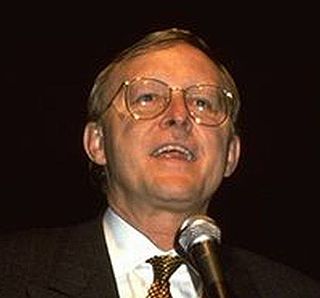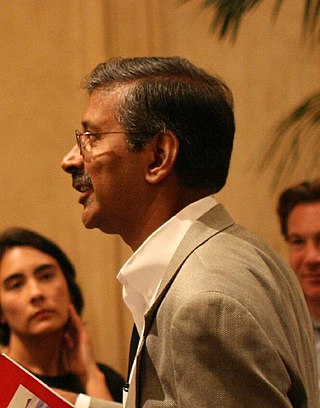The James H. Clark Center (also abbreviated to the Clark Center) at Stanford University, California, United States, is a building, completed in 2003, that houses interdisciplinary research in the biological sciences.
The James H. Clark Center (also abbreviated to the Clark Center) at Stanford University, California, United States, is a building, completed in 2003, that houses interdisciplinary research in the biological sciences.
The former Stanford computer scientist and entrepreneur James H. Clark donated $90 million of the total cost of $150 million to fund construction of the James H. Clark Center for interdisciplinary biomedical research. [1] Construction started in 2001 and was completed in the summer of 2003, as part of the Stanford University Bio-X program. [2] In September 2001, Clark rescinded $60 million of his initial 1999 pledge of $150 million to Stanford University for Bio-X, citing anger over President George W. Bush's restrictions on stem cell research. [3] The building opened on October 24, 2003. [4]
The building was designed by Foster and Partners [5] in collaboration with MBT Architecture, and was funded by donations from James H. Clark and Atlantic Philanthropies. [6]
The Clark Center is home to Stanford's Bio-X Program, which seeks to encourage researchers in the biological sciences to interact with researchers in other fields. It is a prime example of Stanford's interest in fostering a multidisciplinary approach to research.
Some of the researchers who are members of the Bio-X program include Robert Sapolsky, [7] Ami Bhatt, [8] Jonathan K. Pritchard, [9] Molly Schumer, [10] Natalia Gomez-Ospina, [11] Lynette Cegelski, [12] and Julie Baker. [13]

James Henry Clark is an American entrepreneur and computer scientist. He founded several notable Silicon Valley technology companies, including Silicon Graphics, Netscape, myCFO, and Healtheon. His research work in computer graphics led to the development of systems for the fast rendering of three-dimensional computer images.
Stanford University School of Medicine is the medical school of Stanford University and is located in Stanford, California. It traces its roots to the Medical Department of the University of the Pacific, founded in San Francisco in 1858. This medical institution, then called Cooper Medical College, was acquired by Stanford in 1908. The medical school moved to the Stanford campus near Palo Alto, California, in 1959.
The Stanford Graduate School of Business is the graduate business school of Stanford University, a private research university in Stanford, California. For several years it has been the most selective business school in the United States, admitting only about 6% of applicants.

The Cecil H. Green Library is the main library on the Stanford University campus and is part of the SUL system. It is named for Cecil H. Green.

Robert Morris Sapolsky is an American neuroendocrinology researcher and author. He is a professor of biology, neurology, neurological sciences, and neurosurgery at Stanford University. In addition, he is a research associate at the National Museums of Kenya.
Jack O'Dell was an African-American activist writer and communist, best known for his role in the civil rights movement of the 1950s and 1960s. During World War II, he was an organizer for the National Maritime Union. He was also involved with the Communist Party USA (CPUSA) and the Southern Christian Leadership Conference (SCLC) as well as working with Martin Luther King Jr.

Jennifer A. Richeson is an American social psychologist who studies racial identity and interracial interactions. She is currently the Philip R. Allen Professor of Psychology at Yale University where she heads the Social Perception and Communication Lab. Prior to her appointment to the Yale faculty, Richeson was Professor of Psychology and African-American studies at Northwestern University. In 2015, she was elected to the United States National Academy of Sciences. Richeson was elected to the American Philosophical Society in 2022. Since 2021, she has been a member of the President’s Council of Advisors on Science and Technology (PCAST).

Kavitark Ram Shriram is an Indian-American billionaire businessman and philanthropist. He is a founding board member and one of the first investors in Google. He worked earlier in Amazon. Shriram came to Amazon.com in August 1998, when the company acquired Junglee, an online comparison shopping firm of which Shriram was president. Before Junglee and Amazon, Shriram was a member of the Netscape executive team, joining them in 1994, before they shipped products or posted revenue.

Willie Christine King Farris was an American teacher and civil rights activist, the eldest sibling of Martin Luther King Jr. She taught at Spelman College and was the author of several books and was a public speaker on various topics, including the King family, multicultural education, and teaching.
Samuel Karlin was an American mathematician at Stanford University in the late 20th century.

Jennifer Widom is an American computer scientist known for her work in database systems and data management. She is notable for foundational contributions to semi-structured data management and data stream management systems. Since 2017, Widom is the dean of the School of Engineering and professor of computer science at Stanford University. Her honors include the Fletcher Jones Professor of Computer Science and multiple lifetime achievement awards from the Association for Computing Machinery.
The Carl Sagan Prize for Science Popularization is an annual $5,000 award presented in honor of the late scientist Carl Sagan by Wonderfest, the San Francisco Bay Area Beacon of Science, to a scientist who has "contributed mightily to the public understanding and appreciation of science."
This is the history of Stanford University.
Jelena Vučković is a Serbian-born American professor and Chair of the Department of Electrical Engineering at Stanford University, and a courtesy faculty member in the Department of Applied Physics at Stanford University. Vučković leads the Nanoscale and Quantum Photonics (NQP) Lab, and is a faculty member of the Ginzton Lab, PULSE Institute, SIMES Institute, and Bio-X at Stanford. She was the inaugural director of the Q-FARM initiative. She is a Member of the National Academy of Sciences, and a Fellow of The Optical Society, the American Physical Society and the Institute of Electrical and Electronics Engineers.
Alexandria Boehm is an American scientist whose field of study is civil and environmental engineering. She studies sources, fate and transport of pathogens outside the human body, and coastal water quality. Boehm is a senior fellow at Stanford University's Woods Institute for the Environment and an associate professor in Stanford University's Department of Civil and Environmental Engineering.
Ami Bhatt is an American physician-scientist who studies the link between blood cancers and the human gut microbiome. She holds associate professorships in Genetics and Medicine (Hematology) at Stanford University. She is a member of Stanford Bio-X, the Stanford Cancer Institute, Stanford Maternal & Child Health Research Institute (MCHRI), and Stanford ChEM-H. In addition, Bhatt is the co-founder of Global Oncology Inc., a nonprofit focused on providing quality oncologic treatment in resource-constrained settings.
Molly Schumer is an American scientist who studies evolution, hybridization, and population genetics. She is an assistant professor of biology at Stanford University. She is a member of Stanford Bio-X and a Hannah H. Grey Fellow at the Howard Hughes Medical Institute.
Julie Baker is an American biologist who studies genetics and genomics, cell fate determination, and cellular communication. She is a professor of Genetics at the Stanford University School of Medicine and is a member of Stanford Bio-X and the Stanford Maternal & Child Health Research Institute (MCHRI).
Natalia Gomez-Ospina is a Colombian physician-scientist who studies genetic disorders and lysosomal storage disorders. She was born in Medellín, Colombia. She is an Assistant Professor of Pediatrics (Genetics) and of Pediatrics at Stanford University and works at Lucile Packard Children's Hospital. She is a member of Stanford Bio-X.
Lynette Cegelski is an American physical chemist and chemical biologist who studies extracellular structures such as biofilms and membrane proteins. She is an associate professor of chemistry and, by courtesy, of chemical engineering at Stanford University. She is a Stanford Bio-X and Stanford ChEM-H affiliated faculty member.
The building's other major donor, previously anonymous, was The Atlantic Philanthropies, which contributed $60 million.